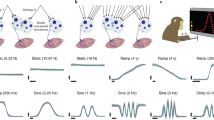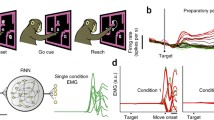Abstract
A mathematical muscle model is presented that relates neural control signals linearly to muscle force without violating important known physiological constraints, such as the size-principle (Henneman and Mendell 1981) and non-linear twitch summation (Burke et al. 1976). This linearity implies that the neural control signals (defined as a weighted sum of activities in a nerve bundle) can be interpreted as the internal representation of total muscle force. The model allows for different relative contributions from the two force-grading mechanisms, i.e. the recruitment of motor units and the modulation of their firing frequency. It can therefore be applied to a variety of (distal and proximal) muscles. Furthermore, it permits simple mechanisms for controlling muscle force, e.g. in superposed motor tasks. The model confirms our intuitive notion that a weighted sum of activities in a nerve bundle can directly represent an external controlled variable, which in this case is exerted muscle force.
Similar content being viewed by others
References
Binder-MacLeod SA, Clamann HP (1989) Force output of cat motor units stimulated with trains of linearly varying frequency. J Neurophysiol 61:208–217
Botterman BR, Iwamoto GA, Gonyea WJ (1986) Gradation of isometric tension by different activation rates in motor units of cat flexor carpi radialis muscle. J Neurophysiol 56:494–506
Burke RE (1973) On the central nervous system control of fast and slow twitch motor units. In: Desmedt JE (eds) New developments in electromyography and clinical neurophysiology. Am Physiol Soc 3:69–94
Burke RE (1981) Motor units: anatomy, physiology, and functional organization. In: Brookhart JM, Mountcastle VB (eds) Handbook of physiology. The nervous system. Motor control, vol II. Bethesda, pp 345–422
Burke RE, Jankowska E, Ten Bruggencate G (1970) A comparison of peripheral and rubrospinal synaptic input to slow and fast twitch motor units of triceps surae. J Physiol (London) 207:709–732
Burke RE, Rudomin P, Zajac FE III (1976) The effect of activation history on tension production by individual muscle units. Brain Res 109:515–529
Calancie B, Bawa P (1985) Voluntary and reflexive recruitment of flexor carpi radialis motor units in humans. J Neurophysiol 53:1194–1200
Clamann HP (1970) Activity of single motor units during isometric tension. Neurology 20:254–260
Conway BA, Hultborn H, Kiehn O, Mintz I (1988) Plateau potentials in α-motoneurones induced by intravenous injection of L-DOPA and clonidine in the spinal cat. J Physiol (London) 405:369–384
DeLuca CJ, Lefever RS, McCue MP, Xenakis AP (1982) Behaviour of human motor units in different muscles during linearly varying contractions. J Physiol (London) 329:113–128
Denier van der Gon JJ (1988) Motor control: aspects of its organisation, control signals and properties. In: Wallinga W, Boom HBK, de Vries J (eds) Electrophysiol kinesiology. Elsevier, Amsterdam, pp 9–17
Denier van der Gon JJ, Haar Romeny BM ter, Zuylen EJ van (1985) Behaviour of motor units of human arm muscles: differences between slow isometric contraction and relaxation. J Physiol 359:107–118
Garnett R, Stephens JA (1981) Changes in the recruitment threshold of motor units produced by cutaneous stimulation in man. J Physiol (London) 311:463–473
Haar Romeny BM ter, Denier van der Gon JJ, Gielen CCAM (1982) Changes in the recruitment order of motor units in human m. biceps muscle. Exp Neurol 78:360–368
Haar Romeny BM ter, Denier van der Gon JJ, Gielen CCAM (1984) Relation of the location of a motor unit in human biceps muscle and its critical firing levels for different tasks. Exp Neurol 85:631–650
Hatze H (1977a) A myocybernetic control model of skeletal muscle. Biol Cybern 25:103–119
Hatze H (1977b) The relative contribution of motor unit recruitment and rate coding to the production of static isometric muscle force. Biol Cybern 27:21–25
Henneman E, Mendell LM (1981) Functional organization of motoneuron pool and its inputs. In: Brookhart JM, Mountcastle VB (eds) Handbook of Physiology. The nervous system. Motor control, vol II. Am Physiol Soc, Bethesda, pp 423–507
Inbar FI, Ginat T (1983a) Parallel nonlinear neuronal channels: the generalized steady-state analysis. IEEE Trans Biomed Cybern (Vol SMC-13) 5:1033–1037
Inbar FI, Ginat T (1983b) Effects of muscle model parameter dispersion and multi-loop segmental interaction on the neuromuscular system performance. Biol Cybern 48:69–83
Jongen HAH, Denier van der Gon JJ, Gielen CCAM (1989) Activation of human arm muscles during flexion/extension and supination/ pronation tasks: a theory on muscle coordination. Biol Cybern 61:1–9
Jorgensen K, Bankov S (1971) Maximum strength of elbow flexors with pronated and supinated forearm. In: Desmedt JE (eds) Biomechanics II; Medicine and sport, vol 6. Karger, Basel, pp 174–180
Kernell D (1990) Spinal motoneurons and their muscle fibers: mechanisms and long-term consequences of common activation patterns. In: Binder MD, Mendell LM (eds) The segmental motor system. Oxford University Press, New York Oxford, pp 36–57
Kernell D, Eerbeek O, Verhey BA (1983a) Motor unit categorization on basis of contractile properties: an experimental analysis of the composition of the cat's m. peroneus longus. Exp Brain Res 50:211–219
Kernell D, Eerbeek O, Verhey BA (1983b) Relation between isometric force and stimulus rate in cat's hindlimb motor units of different twitch contraction time. Exp Brain Res 50:220–227
Kukulka CG, Clamann HP (1981) Comparison of the recruitment and discharge properties of motor units in human brachial biceps and adductor pollicis during isometric contractions. Brain Res 219:45–55
Kuypers HGJM (1985) The anatomical and functional organization of the motor system. In: Swash M, Kennard C (eds) The scientific basis of clinical neurology. Churchill Livingston, Edinburgh
Mendell LM, Collins III WF, Koerber HR (1990) How are Ia synapses distributed on spinal motoneurons to permit orderly recruitment. In: Binder MD, Mendell LM (eds) The segmental motor system. Oxford University Press, New York Oxford, pp 308–327
Milner-Brown HS, Stein RB, Yemm R (1973a) The orderly recruitment of human motor units during voluntary isometric contractions. J Physiol (London) 230:359–370
Milner-Brown HS, Stein RB, Yemm R (1973b) Changes in firing rate of human motor units during linearly changing voluntary contractions. J Physiol (London) 230:371–390
Monster AW, Hing Chang (1977) Isometric force production by motor units of extensor digitorum communis muscle in man. J Neurophysiol 40:1432–1443
Munson JB (1990) Synaptic inputs to type-identified motor units. In: Binder MD, Mendell LM (eds) The segmental motor system. Oxford University Press, New York Oxford, pp 291–307
Person RS, Kudina LP (1972) Discharge frequency and discharge pattern of human motor units during voluntary contraction of muscle. Electroencephalogr Clin Neurophysiol 32:471–483
Rüegg DG, Bongoianni F (1989) Superposition of ballistic on steady contractions in man. Exp Brain Res 77:412–420
Tax AAM, Denier van der Gon JJ, Gielen CCAM, Tempel van den CMM (1989) Differences in the activation of m. biceps brachii in the control of slow isotonic movements and isometric contractions. Exp Brain Res 76:55–63
Traub RD (1977) A model of a human neuromuscular system for small isometric tensions. Biol Cybern 26:159–167
Wadman WJ, Boerhout W, Denier van der Gon JJ (1980) Responses of the arm movement control system to force impulses. J Hum Mov Studies 6:280–302
Wani AM, Guha SK (1975) A model for gradation of tension-recruitment and rate-coding. Med Biol Eng 13:870–875
Windhorst U, Hamm TM, Stuart DG (1989) On the function of muscle and reflex partitioning. Behav Brain Sci 12:629–681
Zajac FE, Young JL (1980) Properties of stimulus trains producing maximum tension-time area per pulse from single motor units in medial gastrocnemius muscle of the cat. J Neurophysiol 43:1206–1220
Zuylen EJ van, Gielen CCAM, Denier van der Gon JJ (1988) Coordination and inhomogeneous activation of human arm muscles during isometric torques. J Neurophysiol 60:1523–1548
Author information
Authors and Affiliations
Rights and permissions
About this article
Cite this article
Tax, A.A.M., Denier van der Gon, J.J. A model for neural control of gradation of muscle force. Biol. Cybern. 65, 227–234 (1991). https://doi.org/10.1007/BF00206220
Received:
Accepted:
Issue Date:
DOI: https://doi.org/10.1007/BF00206220




